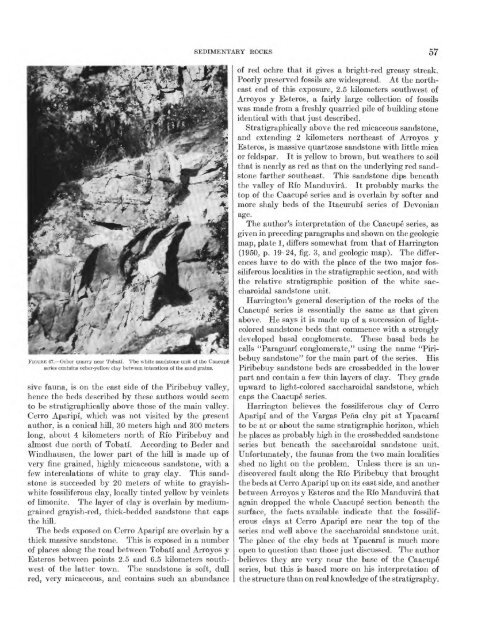Geology and Mineral Resources of Paraguay A Reconnaissance
Geology and Mineral Resources of Paraguay A Reconnaissance
Geology and Mineral Resources of Paraguay A Reconnaissance
- No tags were found...
Create successful ePaper yourself
Turn your PDF publications into a flip-book with our unique Google optimized e-Paper software.
SEDIMENTARY ROCKS 57<strong>of</strong> red ochre that it gives a bright-red greasy streak.Poorly preserved fossils are widespread. At the northeastend <strong>of</strong> this exposure, 2.5 kilometers southwest <strong>of</strong>.Arroyos y Esteros, a fairly large collection <strong>of</strong> fossilswas made from a freshly quarried pile <strong>of</strong> building stoneidentical with that just described.Stratigraphically above the red micaceous s<strong>and</strong>stone,<strong>and</strong> extending 2 kilometers northeast <strong>of</strong> Arroyos yEsteros, is massive quartzose s<strong>and</strong>stone with little micaor feldspar. It is yellow to brown, but weathers to soilthat is nearly as red as that on the underlying red s<strong>and</strong>stonefarther southeast. This s<strong>and</strong>stone dips beneaththe valley <strong>of</strong> Rio M<strong>and</strong>uvira. It probably marks thetop <strong>of</strong> the Caacupe series <strong>and</strong> is overlain by s<strong>of</strong>ter <strong>and</strong>more shaly beds <strong>of</strong> the Itacurubi series <strong>of</strong> DevonianFIGURE 47. Ocher quarry near Tobati. The white s<strong>and</strong>stone unit <strong>of</strong> the Caacupfiseries contains ocher-yellow clay between interstices <strong>of</strong> the s<strong>and</strong> grains.sive fauna, is on the east side <strong>of</strong> the Piribebuy valley,hence the beds described by these authors would seemto be stratigraphically above those <strong>of</strong> the main valley.Cerro Aparipi, which was not visited by the presentauthor, is a conical hill, 30 meters high <strong>and</strong> 300 meterslong, about 4 kilometers north <strong>of</strong> Rio Piribebuy <strong>and</strong>almost due north <strong>of</strong> Tobati. According to Beder <strong>and</strong>Windhausen, the lower part <strong>of</strong> the hill is made up <strong>of</strong>very fine grained, highly micaceous s<strong>and</strong>stone, with afew intercalations <strong>of</strong> white to gray clay. This s<strong>and</strong>stoneis succeeded by 20 meters <strong>of</strong> white to grayishwhitefossiliferous clay, locally tinted yellow by veinlets<strong>of</strong> limonite. The layer <strong>of</strong> clay is overlain by mediumgrainedgrayish-red, thick-bedded s<strong>and</strong>stone that capsthe hill.The beds exposed on Cerro Aparipi are overlain by athick massive s<strong>and</strong>stone. This is exposed in a number<strong>of</strong> places along the road between Tobati <strong>and</strong> Arroyos yEsteros between points 2.5 <strong>and</strong> 6.5 kilometers southwest<strong>of</strong> the latter town. The s<strong>and</strong>stone is s<strong>of</strong>t, dullred, very micaceous, <strong>and</strong> contains such an abundanceThe author's interpretation <strong>of</strong> the Caacupe series, asgiven in preceding paragraphs <strong>and</strong> shown on the geologicmap, plate 1, differs somewhat from that <strong>of</strong> Harrington(1950, p. 19-24, fig. 3, <strong>and</strong> geologic map). The differenceshave to do with the place <strong>of</strong> the two major fossiliferouslocalities in the stratigraphic section, <strong>and</strong> withthe relative stratigraphic position <strong>of</strong> the white saccharoidals<strong>and</strong>stone unit.Harrington's general description <strong>of</strong> the rocks <strong>of</strong> theCaacupe series is essentially the same as that givenabove. He says it is made up <strong>of</strong> a succession <strong>of</strong> lightcoloreds<strong>and</strong>stone beds that commence with a stronglydeveloped basal conglomerate. These basal beds hecalls "Paraguari conglomerate," using the name "Piribebuy s<strong>and</strong>stone" for the main part <strong>of</strong> the series. HisPiribebuy s<strong>and</strong>stone beds are crossbedded in the lowerpart <strong>and</strong> contain a few thin laj^ers <strong>of</strong> clay. They gradeupward to light-colored saccharoidal s<strong>and</strong>stone, whichcaps the Caacupe series.Harrington believes the fossiliferous clay <strong>of</strong> CerroAparipi <strong>and</strong> <strong>of</strong> the Vargas Pena clay pit at Ypacaraito be at or about the same stratigraphic horizon, whichhe places as probably high in the crossbedded s<strong>and</strong>stoneseries but beneath the saccharoidal s<strong>and</strong>stone unit.Unfortunately, the faunas from the two main localitiesshed no light on the problem. Unless there is an undiscoveredfault along the Rio Piribebuy that broughtthe beds at Cerro Aparipi up on its east side, <strong>and</strong> anotherbetween Arroyos y Esteros <strong>and</strong> the Rio M<strong>and</strong>uvira thatagain dropped the whole Caacupe section beneath thesurface, the facts available indicate that the fossiliferousclays at Cerro Aparipi are near the top <strong>of</strong> theseries <strong>and</strong> well above the saccharoidal s<strong>and</strong>stone unit.The place <strong>of</strong> the clay beds at Ypacarai is much moreopen to question than those just discussed. The authorbelieves they are very near the base <strong>of</strong> the Caacupeseries, but this is based more on his interpretation <strong>of</strong>the structure than on real knowledge <strong>of</strong> the stratigraphy.
















